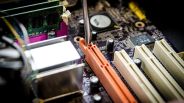After Thursday's test flight of SpaceX's Starship, it became apparent that the enormous power from its 33 first-stage engines had inflicted ample damage to its launch site in Texas.
Devastation Left Behind After 120-Meter Rocket Launch
Though the 120-meter rocket had successfully lifted off, flying for about four minutes until it tumbled and exploded over the Gulf of Mexico, photos of the launch site show a scene of desolation, with a huge crater underneath the launch mount that was still intact.
According to the story by ABC, images of debris spread as far as 420 meters away, and some reports suggest that a cloud of dust had even reached a small town in the area.
Elon Musk, the company's chief executive, acknowledged afterward that the launch pad had most likely been shattered by the force of the engines.
Ensuring Public Safety: Repairing the Launch Pad and Understanding the Malfunction
To prepare for another test attempt and appease the Federal Aviation Administration (FAA), which is leading an investigation into the flight's aftermath, SpaceX must determine the reasons behind the malfunction and ensure that they don't threaten public safety.
As FAA enforcement administrator Steve Dickson said in a statement, no new tests would be authorized otherwise, as explained further in an article by Phys.org.
It is believed that repairing the launch pad will take several months, and the lack of a water deluge system and flame trench at the Texas site certainly contributed to the damage.
Investing in SpaceX's Improvements: Less Failures, More Successes
MIT professor of astronautics and engineering Olivier de Weck suggested that a huge, water-cooled steel plate placed beneath the launch mount would be a good solution.
However, such a feature comes at a high price and could be hard to withstand the Earth-shaking power of Starship. Equally important is the fact that SpaceX, and Elon Musk in particular, is willing to take risks and break things.
But, in their famous fashion, they also quickly learn and improve. Professor de Weck claims that Thursday's test flight was "more a success than a failure," so, hopefully, after months of repair works, the Starship rocket will be ready for another attempt and could lead the way to more ambitious NASA Moon missions.
Read Also: Astronomers Discover Heaviest Element Ever Found in 'Ultra-Hot Jupiter' Exoplanet
Gaining FAA Approval and Analyzing Test Performance to Push Space Exploration Further
One thing is for sure - the world is watching, and we can all look forward to more impressive feats from SpaceX in the near future. Besides protecting the launch pad, Mr. Musk and his team must also persuade the US Federal Aviation Administration (FAA) to authorize a new test launch.
Also, the team must pinpoint any problems from the previous test and make any appropriate changes to Starship, as several of its 33 engines appeared to malfunction during the flight.
The test put Starship's capabilities to the test and may have provided more insight into how large rocket launches should be approached. With further details revealed in an article by Business Insider.
Related Article: NASA's Floating Balloon Telescope SuperBIT Captures Tarantula Nebula in Gorgeous Detail

ⓒ 2025 TECHTIMES.com All rights reserved. Do not reproduce without permission.




